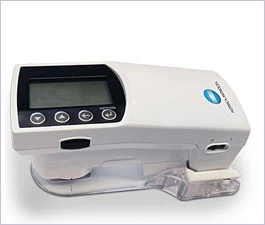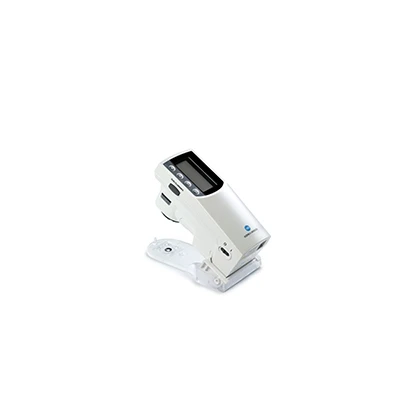FD-5 Spectrodensitometer
Provides accurate evaluation, even on substrates with fluorescent whitening agents
As digital methods are increasingly used in graphics-related industries, there is a growing reliance on numerical control of the quality of printed materials, being both easier and faster than the visual evaluation the human eye can manage. However, since ultimately the final materials are intended to be seen by the human eye, the final measurement results must closely resemble the human eye results of visual evaluation.
The fact that the paper on which materials are printed influences the final viewed color is a potential problem. Fluorescent whitening agents (FWAs) are contained in many kinds of paper used for printing to give paper a brighter appearance, which can have a particularly large effect on the color of the printed materials when they’re viewed under Illuminant D50*1. For that reason, ISO 13655-2009*2 defined Measurement Condition M1 as having illumination corresponding to CIE Illuminant D50, which minimizes differences in measurement results due to paper fluorescence. This effect was very difficult to measure with conventional, previously available, handheld spectrodensitometers.
By utilizing Konica Minolta’s original VFS (Virtual Fluorescence Standard) technology, the FD-5 Spectrodensitometer offers unique solutions to this problem, enabling color evaluation while taking into consideration the fluorescence of the paper under Illuminant D50, the printing industry’s standard light source used for color evaluation. These instruments are the first to provide measurement results corresponding to ISO 13655 Measurement Condition M1.
*1 An artificial light source defined by the CIE as having a spectral distribution simulating daylight commonly used for color measurement.
*2 ISO 13655-2009: Graphic technology – Colorimetric computation spectral measurement and for graphic arts images
Accurate evaluation, even on substrates with fluorescent whitening agents
- Color and density control by printers
- Measurement of fluorescence in R & D of paper manufacturers and printing machinery manufacturers
- Printed color patch measurements
- Ink CCM systems input sensor

FD-5 Spectrodensitometer
For Measuring Color and Density
Uniquely corresponds to Measurement Condition M1 of ISO 13655
- The first M1 type in the world.
- Konica Minolta’s original VFS (Virtual Fluorescence Standard) technology enables L*a*b* measurements corresponding to ISO 13655 Measurement Condition M1 (CIE Illuminant D50).
In addition, color measurements can also be taken which correspond to ISO 13655 Measurement Conditions M0 (CIE Illuminant A) and M2 (illumination with UV-cut filter).
Automatic wavelength compensation function is industry’s first
- Without requiring additional work, wavelength compensation is performed during white calibration.
- Wavelength compensation could only be carried out as one part of manufacturer servicing until now.
Now whenever white calibration is done, this task is performed, helping to maintain the measurement values until the next periodic servicing with high reliability.
Enables color measurements that correspond with visual evaluation more closely.
- With the new FD-7/FD-5, measurement results correspond more closely to visual evaluation results, including the effects of any fluorescent whitening agents (FWA) in the paper, whereas previously, using conventional instruments to measure materials printed on substrates containing FWA, large differences could occur between the results of measurements and visual evaluation.
Simple operation
- Measurements of density, dot gain, dot area ratio, illumination, and color, are very simple.
- Anyone can take measurements easily with the instructions in the LCD screen guide operation.
World’s lightest*1
With weight only about 350g for the main body, and only 430g even with the target mask attached, its lighter than any previous spectrodensitometer. The load on the user’s arm during work is reduced, improving efficiency especially when when the user is spends a long time taking measurements.
*1 As of November 1, 2010, display-equipped spectrodensitometer.
Worry-free after-sales service
- Rapid support when needed provided by worldwide service centers.
- Your instrument is always in top shape, ensured by a comprehensive service network is in place.
Printing Color Management Software BasICColor catch all (Optional accessory)
- Screen can be easily customized with pass/fail screen, data list view, 3D graph, etc.
- Various test charts are compatible (MediaWedge, ECI2002, IT8.7/3, etc.)
FD-5 Spectrodensitometer
| Model | FD-5 |
|---|
| Illumination/viewing system | 45°a: 0°(annular illumination) *1
Conforms to CIE No. 15, ISO 7724/1, DIN 5033 Teil 7, ASTM E 1164, and JIS Z 8722 Condition a for reflectance measurements |
| Spectral separation device | Concave grating |
| Wavelength range | Spectral reflectance: 360 nm to 740 nm |
| Wavelength pitch | 10 nm |
| Measurement area | Φ3.5 mm |
| Light source | LED |
| Measurement range | Density: 0.0D to 2.5D; Reflectance: 0 to 150% |
| Short-term repeatability | Density: σ0.01D
Colorimetric: Within σΔE00 0.05 (When white plate is measured 30 times at 10-second intervals after white calibration has been performed) |
| Inter-instrument agreement | Within ΔE00 0.3 (Average of 12 BCRA Series II color tiles compared to values measured with a master body under Konica Minolta standard conditions) |
| Measurement time | Approx. 1.4 s (single-point reflectance measurement) |
| Displayed values | Colorimetric values, color-difference values, density values, density-difference values, dot area ratio, dot gain, PASS/FAIL judgment |
| Measurement conditions | Corresponding to ISO 13655 Measurement Conditions M0 (CIE Illuminant A), M1 (CIE Illuminant D50), and M2 (illumination with UV-cut filter); User-defined illuminant |
| Illuminants | A, C, D50, ID50, D65, ID65, F2, F6, F7, F8, F9, F10, F11, F12, User-defined illuminant |
| Observers | 2° Standard Observer, 10° Standard Observer |
| Color spaces | L*a*b*, L*C*h, Hunter Lab, Yxy, XYZ, and color differences in these color spaces |
| Color-difference equations | ΔE*ab (CIE 1976), ΔE*94 (CIE 1994), ΔE00 (CIE 2000), ΔE (Hunter), CMC (l: c) |
| Indexes | WI (ASTM E 313-96); Tint (ASTM E 313-96); ISO Brightness (ISO 2470-1); D65 Brightness (ISO 2470-2); Fluorescence index |
| Density | ISO Status T, ISO Status E, ISO Status A; DIN 16536 |
| Storable data | Colorimetric target data: 30 data; Density target data: 30 data |
| Display language | English, French, German, Spanish, Japanese, Chinese (Simplified) |
| Scanning measurements*2 | N/A |
| Interface | USB 2.0 |
| Output data*2 | Displayed values |
| Power | Rechargeable internal lithium-ion battery (Number of measurements per charge: Approx. 2,000 when new); AC adapter; USB power bus |
| Dimensions (W × D × H) | 70 × 165 × 83 mm (Body only);
90 × 172 × 84 mm (With target mask attached) |
| Weight | Approx. 350 g (Body only); Approx. 430 g (With target mask attached) |
| Operating temperature / humidity range (*1) | 10 to 35°C, 30 to 85% relative humidity with no condensation |
| Storage temperature/humidity range | 0 to 45°C, 0 to 85% relative humidity with no condensation |
Specifications are subject to change without notice.
∗1 Illumination for wavelengths under 400nm is unidirectional.
∗2 Available when using PC software.
FD-5 Spectrodensitometer
Catalog Download: Download PDF (2.8MB)
Owner’s Manual: Download PDF (193KB)
Demonstration Application Guide: Download PDF (434KB)
Case Study: Clemson University: Understanding and Controlling Color Download PDF (2MB)





